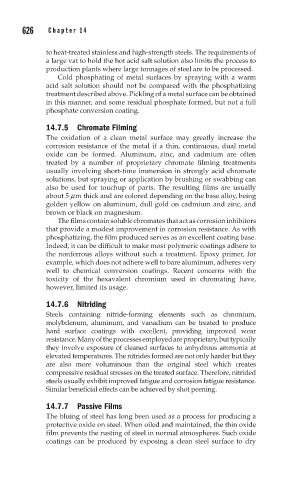Page 672 - Corrosion Engineering Principles and Practice
P. 672
626 C h a p t e r 1 4 P r o t e c t i v e C o a t i n g s 627
to heat-treated stainless and high-strength steels. The requirements of
a large vat to hold the hot acid salt solution also limits the process to
production plants where large tonnages of steel are to be processed.
Cold phosphating of metal surfaces by spraying with a warm
acid salt solution should not be compared with the phosphatizing
treatment described above. Pickling of a metal surface can be obtained
in this manner, and some residual phosphate formed, but not a full
phosphate conversion coating.
14.7.5 Chromate Filming
The oxidation of a clean metal surface may greatly increase the
corrosion resistance of the metal if a thin, continuous, dual metal
oxide can be formed. Aluminum, zinc, and cadmium are often
treated by a number of proprietary chromate filming treatments
usually involving short-time immersion in strongly acid chromate
solutions, but spraying or application by brushing or swabbing can
also be used for touchup of parts. The resulting films are usually
about 5 m m thick and are colored depending on the base alloy, being
golden yellow on aluminum, dull gold on cadmium and zinc, and
brown or black on magnesium.
The films contain soluble chromates that act as corrosion inhibitors
that provide a modest improvement in corrosion resistance. As with
phosphatizing, the film produced serves as an excellent coating base.
Indeed, it can be difficult to make most polymeric coatings adhere to
the nonferrous alloys without such a treatment. Epoxy primer, for
example, which does not adhere well to bare aluminum, adheres very
well to chemical conversion coatings. Recent concerns with the
toxicity of the hexavalent chromium used in chromating have,
however, limited its usage.
14.7.6 Nitriding
Steels containing nitride-forming elements such as chromium,
molybdenum, aluminum, and vanadium can be treated to produce
hard surface coatings with excellent, providing improved wear
resistance. Many of the processes employed are proprietary, but typically
they involve exposure of cleaned surfaces to anhydrous ammonia at
elevated temperatures. The nitrides formed are not only harder but they
are also more voluminous than the original steel which creates
compressive residual stresses on the treated surface. Therefore, nitrided
steels usually exhibit improved fatigue and corrosion fatigue resistance.
Similar beneficial effects can be achieved by shot peening.
14.7.7 Passive Films
The bluing of steel has long been used as a process for producing a
protective oxide on steel. When oiled and maintained, the thin oxide
film prevents the rusting of steel in normal atmospheres. Such oxide
coatings can be produced by exposing a clean steel surface to dry

